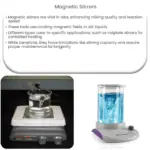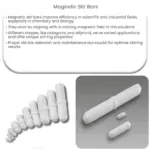A magnetic stirrer works by using a rotating magnet inside the base to generate a magnetic field, which spins a stirring bar, efficiently mixing liquids.
How Does a Magnetic Stirrer Work?
A magnetic stirrer is a laboratory instrument used to mix liquids in a controlled and efficient manner. It is commonly found in research, industrial, and educational settings. In this article, we will explore the inner workings of a magnetic stirrer, its components, and its applications.
Components of a Magnetic Stirrer
- Base: The base is the main body of the device, providing a stable platform for the stirring process. It often contains the motor and the control panel for adjusting stirring speed.
- Magnet: A small, rotating magnet is located inside the base. This magnet is responsible for generating the magnetic field that drives the stirring process.
- Stirring bar: The stirring bar is a small, magnetized rod or capsule, typically coated with PTFE (polytetrafluoroethylene) for chemical resistance. It is placed inside the container holding the liquid to be mixed.
- Control panel: The control panel is used to adjust the speed of the rotating magnet, which in turn determines the stirring speed.
Operating Principle
The operation of a magnetic stirrer relies on the principle of magnetism. When the device is switched on, the rotating magnet inside the base generates a rotating magnetic field. This field induces a magnetic force on the stirring bar, causing it to spin rapidly. As the stirring bar spins, it agitates the liquid, resulting in efficient mixing.
The speed of the spinning magnet, and therefore the stirring speed, can be adjusted using the control panel. Some magnetic stirrers also come with a heating element, allowing for simultaneous heating and stirring.
Advantages of Magnetic Stirrers
- Efficient mixing: Magnetic stirrers provide uniform and consistent mixing of liquids without the need for manual intervention.
- Precise control: The adjustable speed settings allow users to control the stirring intensity, making it suitable for a wide range of applications.
- Chemical resistance: The PTFE-coated stirring bars are resistant to most chemicals, ensuring the stirrer can be used with various types of liquids.
- Low maintenance: With no direct contact between the stirring bar and the device, magnetic stirrers have minimal wear and tear, resulting in low maintenance requirements.
In conclusion, magnetic stirrers are versatile and efficient tools for mixing liquids in laboratory settings. Their simple yet effective design, based on the principle of magnetism, ensures precise control and consistent results in a wide range of applications.




